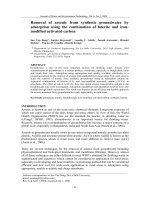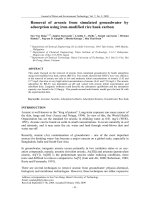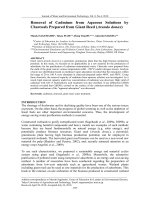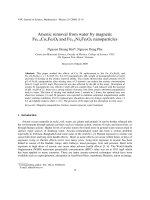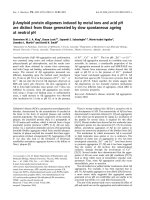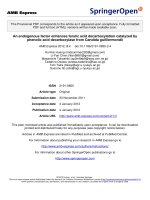Humic acid removal from aqeous solution by hybrid eletrodialysis ion exchange
Bạn đang xem bản rút gọn của tài liệu. Xem và tải ngay bản đầy đủ của tài liệu tại đây (857.18 KB, 138 trang )
HUMIC ACID REMOVAL FROM AQUEOUS SOLUTION BY A
HYBRID ELECTRODIALYSIS/ION-EXCHANGE
CHEN GENTU
(B.Eng., Zhejiang Univ.)
A THESIS SUBMITTED
FOR THE DEGREE OF MASTER OF ENGINEERING
DEPARTMENT OF CHEMICAL AND BIOMOLECULAR
ENGINEERING
NATIONAL UNIVERSITY OF SINGAPORE
2004
ACKNOWLEDGEMENTS
I am deeply indebted to my supervisor, Associate Professor Nikolai. M. Kocherginsky for
his invaluable supervision, continuous and constructive advice, careful reviews of the
thesis through out my study. His strong and thorough grounding in physical chemistry,
electrochemistry, membrane science and technology has benefited me greatly in the study
and will be of great help in my future academic career.
I also wish to thank a number of people who have contributed either directly or indirectly
to this study. Grateful acknowledgment is made to Dr. Yuri Kostetski and Mdm Khoh
Leng Khim, Sandy for their kind help and continuous support. In addition, I would like to
thank all my friends and labmates for making the study full of fun and happiness.
Most importantly, I am grateful to my wife Lu Ya for her love, support and
understanding. Without her, the thesis would have never been written.
Finally, the financial support from National University of Singapore is very much
appreciated.
ii
TABLE OF CONTENTS
TITLE PAGE
ACKNOWLEDGEMENTS
ii
TABLE OF CONTENTS
iii
SUMMARY
vii
NOMENCLATURE
ix
LIST OF FIGURES
xiii
LIST OF TABLES
xviii
CHAPTER 1
INTRODUCTION
1
1.1 Background
1
1.2 Research objectives and scope
8
CHAPTER 2
LITERATURE REVIEW
2.1 Humic acid
10
10
2.1.1 Properties of HA
10
2.1.2 Methods for HA removal
13
2.2 Theoretical background
16
2.2.1 Stability of colloidal systems
16
2.2.2 Double layer
19
iii
2.2.3 Zeta potential
20
2.2.4 Electrokinetic effect
22
2.2.5 Ion exchange resin
24
2.2.6 Electrodialysis
26
2.2.7 Electrodeionization
29
CHAPTER 3
METHODOLOGY
32
3.1 Apparatus
32
3.2 Materials
33
3.3 Instruments and experimental procedures
38
CHAPTER 4
DIFFERENT COMBINATIONS OF ION EXCHANGE
MEMBRANE AND ION EXCHANGE RESIN
42
4.1 Introduction
42
4.2 Results and discussion
43
4.2.1 Resin in the beaker
44
4.2.2 Only membranes
46
4.2.3 MR3 resin and membranes
52
4.2.4 A550 resin and membranes
55
4.2.5 Marathon C resin and membranes
58
4.2.6 Summary and discussion for different combinations of membranes and resin60
4.3 Conclusions
69
iv
CHAPTER 5
EFFECT OF EXPERIMENTAL PARAMETERS ON HA
REMOVAL IN SINGLE-PASS OPERATION MODE FOR A COMBINATION OF
AM+MR3+CM
72
5.1 Introduction
72
5.2 Results and discussion
73
5.2.1 pH change in HA and electrolyte solutions during the experiment
73
5.2.2 Current change of circuit during the experiment
74
5.2.3 Different parameters effect
74
5.2.3.1 Voltage effect
76
5.2.3.2 Electrolyte concentration effect
78
5.2.3.3 Flow rate effect
80
5.2.3.4 HA concentration effect
81
5.2.3.5 pH effect
83
5.2.3.6 Ionic strength effect
84
5.2.3.7 CuSO4 concentration effect
86
5.3 Conclusions
CHAPTER 6
88
EFFECT OF EXPERIMENTAL PARAMETERS ON HA
REMOVAL IN A RECYCLING OPERATION MODE FOR A COMBINATION
OF AM+MR3+CM
90
6.1 Introduction
90
6.2 Results and discussion
90
6.2.1 HA particle size change during the experiment
90
v
6.2.2 pH change in HA and electrolyte solutions during the experiment
91
6.2.3 Current change in the circuit during the experiment
92
6.2.4 Different parameters effect
92
6.2.4.1 Voltage effect
94
6.2.4.2 Electrolyte concentration effect
97
6.2.4.3 Flow rate effect
98
6.2.4.4 HA concentration effect
99
6.2.4.5 pH effect
100
6.2.4.6 Ionic strength effect
101
6.2.4.7 Copper concentration effect
101
6.3 Conclusions
CHAPTER 7
103
SUMMARY AND RECOMMENDATIONS
104
REFERENCES
107
APPENDIX A
114
vi
SUMMARY
This study describes the applicability of hybrid electrodialysis/ion exchange in removing
humic acid (HA) from aqueous solutions. Experiments for different combinations of ion
exchange membrane and ion exchange resin were carried out to investigate the
mechanism of the process. It was found that the combination of AM+MR3+CM is the
most efficient considering the effect of electrical field. In the absence of voltage, hybrid
electrodialysis/ion exchange can remove HA particles due to electrostatic attraction
between HA particles and the surface of membranes and resins. The Anion exchange
resin and an anion exchange membrane can remove HA more efficiently than a cation
exchange resin and a cation exchange membrane. In the presence of an applied voltage, a
much stronger local electric field is induced due to the polarized resin. Initially the HA
particles move under the applied electric field due to electrophoresis; But when the HA
particles come close to the gap between resins, the stronger local electric field makes the
HA particles deposit on the surface of resins. Secondly, the polarized HA particles form
condensed sediments on the deposited HA particles on the surface of resin due to dipoledipole interactions. Thus the electric field greatly enhances the HA deposition on the
surface of resins. When the electric field is switched off, the electric forces and the
dipole-dipole interactions disappear. HA particles are carried away when a fluid flows
through the central chamber. The amount of released HA depends on the properties of
resins, membranes and the feed solution.
Recycling operation mode and single-pass operation mode were used to study the effect
of different parameters on HA removal, i.e. the voltage, the electrolyte concentration, the
vii
flow rate of HA solution, the HA concentration, the pH of HA solution, the ionic strength
of HA solution and the Cu2+ concentration in HA solution. Higher voltage leads to a
higher HA removal. Lower salt concentration and lower HA concentration are desirable
for HA removal. A suitable electrolyte concentration and flow rate are required in
operation. In the recycling operation mode, alkaline pH helps to remove HA the most
efficiently. In the single-pass operation mode, the neutral pH allows to remove HA the
most efficiently. All the results have been physically explained. Also, a mathematical
way was introduced to characterize the process.
viii
NOMENCLATURE
Abbreviations
AM
Anion exchange membrane
CM
Cation exchange membrane
COD
Chemical oxygen demand
DBP
Disinfection by-product
DI
Deionized
DOC
Dissolved organic carbon
ED
Electrodialysis
EDI
Electrodeionization
FA
Fulvic acid
HA
Humic acid
HS
Humic substances
IHP
Inner Helmholtz plane
NF
Nano-filtration
NOM
Natural organic matter
OHP
Outer Helmholtz plane
RO
Reverse osmosis
PAX
Prepolymerized alum
SEM
Scanning electron microscopy
TOC
Total organic carbon
UF
Ultrafiltration
ix
UPS
Uniform particle size
UV
Ultraviolet
Symbols
C
Concentration
ΔCt
Change in concentration of HuA between times t and t + Δt
D
Diffusion coefficient
e
Electron charge
E
Electric field
E
Energy Consumption
F
Faraday constant
i
Current as function of time
I
Electric current
ilim
Limiting current density
k
Mass transport coefficient
JD
Flux of ions by diffusion
Je
Flux of ions by electrotransport
kb
Boltzmann constant
L
Length of central chamber
NA
Avogadro’s number
n
Number of moles transported
q
Charge
Qf
Flow rate
x
r
Distance from surface
R
Universal gas constant
T
Time
Δt
Sampling time
T
Temperature
Up
Particle electrophoretic mobility
vt
Volume of solution at time t
V
Potential difference across condensor
Vf
Volume of feed solution
V0
Potential drop across membranes
Vp
Particle velocity
W
Electrical energy used/mg of HA removed
x
Distance from charged surface
zi
Electrochemical valence
Z
Distance from the inlet of central chamber
Greek Symbols
δ
Distance of the Stern plane from the surface of particle
δ
Thickness of the boundary layer
ε
Dielectric constant of the medium
η
Removal efficiency
ζ
Zeta potential
ξ
Current utilization
xi
λ
Filter coefficient
κ-1
Diffused double layer thickness
τ
Total time for which voltage was applied
ϕDon
Donnan potential
ψ0
Potential at the surface of the particle
ψ
Potential at a distance from the surface of the particle
xii
LIST OF FIGURES
Fig. 1.1
Schematic diagram of the electrodialysis process
2
Fig. 1.2
Water desalination costs as a function of the feed solution
concentration for 1. distillation, 2. ion exchange, 3. electrodialysis,
and 4. reverse osmosis
3
Fig. 1.3
Electrodeionization process unit
6
Fig. 2.1
A hypothetical HA molecule
10
Fig. 2.2
The interaction energy between two colloidal particles as a function
of their distance of separation, when the conditions favor stability
of the colloid
18
Fig. 2.3
The interaction energy between two colloidal particles as a function
of their distance of separation, when the conditions favor
coagulation of the colloid
18
Fig. 2.4
A schematic representation of the distribution of charge near a
charged particle based on the Stern model.
20
Fig. 2.5
A schematic representation of the variation of potential with
distance from a charged particle based on the Stern model.
21
Fig. 2.6
Mass transport in the electrodialysis
27
Fig. 2.7
Diagram of the nickel front. This figure depicts the sections of the
beds in the Ni2+, H+ and Ni2+/H+ forms. The bed is regenerated by
the anolyte, while nickel is concentrated in the cathode
compartment. The nickel solution is fed top-down.
30
Fig. 3.1
Schematic representation of the experimental set-up in a recycling 33
operation mode
xiii
Fig. 3.2
Schematic representation of the experimental set-up in a single-pass
operation mode
33
Fig. 3.3
Schematic representation of the IONICS CR-67 membrane
34
Fig. 3.4
Schematic representation of the IONICS AR-103 membrane
34
Fig. 4.1
HA concentration ratio as a function of time for the resin in the
beaker
45
Fig. 4.2
HA concentration ratio as a function of time for only membrane 48
without resin
Fig. 4.3
HA removal due to electrosorption as a function of time for only 51
membranes without resin
Fig. 4.4a
SEM images showing the morphology of anion exchange 52
membrane surface with HA deposition
Fig. 4.4b
Photo of anion exchange membrane before and after experiments 52
and photo of a fresh cation exchange membrane
Fig. 4.5
HA concentration ratio as a function of time for combinations of
MR3 resin and membranes
Fig. 4.6
HA removal due to electrosorption as a function of time for 54
combination of MR3 resin and membranes
Fig. 4.7
HA concentration ratio as a function of time for a combination of 56
A550 resin and membranes
Fig. 4.8
HA removal due to electrosorption as a function of time for a
combination of A550 resin and membranes
Fig. 4.9
HA concentration ratio as a function of time for a combination of 59
Marathon C resin and membranes
54
57
xiv
Fig. 4.10
HA removal due to electrosorption as a function of time for a 59
combination of Marathon C resin and membranes
Fig. 4.11
Distribution of lines of an electric field’s strength in the gap
between two spherical resin gels in a less conducting solution
66
Fig. 4.12a
HA removal efficiency comparison for two system, one is hybrid
electrodialysis/ion exchange, the other is electrodiaysis plus ion
exchange (MR3 resin)
68
Fig. 4.12b
HA removal efficiency comparison for two system, one is hybrid
electrodialysis/ion exchange, the other is electrodiaysis plus ion
exchange (A550 resin)
68
Fig. 4.12c
HA removal efficiency comparison for two system, one is hybrid
electrodialysis/ion exchange, the other is electrodiaysis plus ion
exchange (Marathon C resin)
69
Fig. 5.1
pH of HA solution and pH of electrolyte solution as a function of 73
time during experiment in single-pass operation mode
Fig. 5.2
Current of circuit as a function of time during experiment in a 74
single-pass operation mode
Fig. 5.3
HA concentration ratio as a function of time for different voltage in 77
a single-pass operation mode
Fig. 5.4
Filter coefficient as a function of voltage for different voltage in a 78
single-pass operation mode
Fig. 5.5
HA concentration ratio as a function of time for different electrolyte 79
concentration in a single-pass operation mode
Fig. 5.6
Filter coefficient as a function of electrolyte concentration in a 79
single-pass operation mode
xv
Fig. 5.7
HA concentration ratio as a function of time for different flow rates 80
in a single-pass operation mode
Fig. 5.80
Filter coefficient as a function of flow rate in a single-pass 81
operation mode
Fig. 5.9
HA concentration ratio as a function of time for different initial HA 82
concentration in single-pass operation mode
Fig. 5.10
Filter coefficient as a function of HA concentration in a single-pass 82
operation mode
Fig. 5.11
HA concentration ratio as a function of time for different pH of HA 83
solution in single-pass operation mode
Fig. 5.12
Filter coefficient as a function of pH of HA solution in a single-pass 84
operation mode
Fig. 5.13
HA concentration ratio as a function of time for different ionic 85
strengths of HA solution in a single-pass operation mode
Fig. 5.14
Filter coefficient as a function of NaCl concentration in HA 85
solution in a single-pass operation mode
Fig. 5.15
HA concentration ratio as a function of time for different copper 87
concentrations in a single-pass operation mode
Fig. 5.16
Filter coefficient as a function of CuSO4 concentration in HA 88
solution in a single-pass operation mode
Fig. 6.1
Effective particle diameter of HA at different time in a recycling 91
operation mode. At 80 min, the voltage was switched off
Fig. 6.2
pH of HA solution and pH of Na2SO4 solution as a function of time 92
during experiment in a recycling operation mode
xvi
Fig. 6.3
HA concentration ratio as a function of time for different voltage in 95
a recycling operation mode
Fig. 6.4
HA removal after 120min as a function of voltage applied in the 95
recycling operation mode
Fig. 6.5
Total electrical energy consumed per mg of HA removed at 96
different values of the applied voltage
Fig. 6.6
Variation of the current with the applied voltage across the module. 97
The time interval between the 5 V step change was 2 min
Fig. 6.7
HA concentration ratio as a function of time for different electrolyte 97
concentration in a recycling operation mode
Fig. 6.8
Current as a function of Na2SO4 concentration in the recycling 98
operation mode with 40 V
Fig. 6.9
HA concentration ratio as a function of time for different flow rate 99
in recycling operation mode
Fig. 6.10
HA concentration ratio as a function of time for different initial HA 100
concentration in a recycling operation mode
Fig. 6.11
Total removed HA as a function of initial HA concentration in a 100
recycling operation mode after 120 min
Fig. 6.12
HA concentration ratio as a function of time for different pH 101
solution in a recycling operation mode
Fig. 6.13
HA concentration ratio as a function of time for different NaCl 102
concentration in the HA suspension in recycling operation mode
Fig. 6.14
HA concentration ratio as a function of time for different CuSO4 102
concentration in the HA suspension in recycling operation mode
xvii
LIST OF TABLES
Table 2-1
Composition of the resins
24
Table 3-1
Properties of ion exchange membranes
35
Table 3-2
Description of the resin
36
Table 3-3
Physical and chemical properties of the three resins
36
Table 3-4
Recommended operating conditions for the three resins
36
Table 4-1
Different combinations of ion exchange membrane and resin
44
Table 4-2
Summary for different combinations of membranes and resins
62
Table 4-3
HA removal efficiency comparison for the two systems (one is hybrid 70
electrodialysis/ion exchange, the other is electrodialysis plus ion
exchange process)
Table 5-1
Different experimental conditions for HA removal in a single-pass
operation mode
75
Table 6-1
Different experimental conditions for HA removal in a recycling
operation mode
93
xviii
Chapter 1
Introduction
1.1 Background
Electrodialysis is an electrochemical separation process, in which an electrically charged
membrane and an electrical potential difference are used to separate ionic species from an
aqueous solution and other uncharged components (Ho, Sirkar, 1992). It is widely used
today in water desalination and table salt production. Other uses of electrodialysis,
especially in the food, drug, and chemical process industries as well as in biotechnology
and wastewater treatment, have recently gained a broader interest and it is stimulated by
the development of new ion-exchange membranes with a better selectivity, a lower
electrical resistance, and improved thermal, chemical, and mechanical properties (
Belfort, 1984; Judd, Jefferson, 2003).
The principle of electrodialysis is illustrated in Figure 1.1, which shows a schematic
diagram of a typical electrodialysis cell arrangement consisting of a series of anion and
cation exchange membranes arranged in an alternating pattern between an anode and a
cathode to form individual cells. A cell consists of a volume with two adjacent
membranes. If an ionic solution is pumped through these cells and an electrical potential
is established between the anode and cathode, the positively charged cations migrate
towards the cathode and the negatively charged anions towards the anode. The cations
pass easily through the negatively charged cation exchange membrane, but are retained
1
by the positively charged anion exchange membrane. Likewise, the negatively charged
anions pass through the anion exchange membrane, but are retained by the cation
exchange membrane. The overall result is an increase in the ion concentration in alternate
compartments, while the other compartments simultaneously become depleted. The
depleted solution is generally referred to as the dilute and the concentrated solution as the
concentrate.
Fig.1.1 Schematic diagram of the electrodialysis process (Ho, Sirkar, 1992)
With the development of electronic, medical and pharmaceutical industries, ultrapure
water is increasingly needed in order to obtain a high quality product. There are several
processes utilized to desalinate water. Strathmann (1984) compared the costs of
desalination by various processes as a function of the feed water salinity, as shown in
Figure 1.2. The figure indicates that for very low feed solution salt concentrations, ion
exchange is the most economical process. At about 500 ppm, electrodialysis becomes a
more economical process. Ion exchange resin has an ion exchange capacity. After ion
exchange, the resin should be regenerated with chemicals. Higher feed water salinity
2
increases the operational cost of an ion exchange resin at a faster rate than others.
Furthermore, it generates second polluted wastewater, which is not suitable for
sustainable development.
Fig.1.2 Water desalination costs as a function of the feed solution concentration for
1.distillation, 2.ion exchange, 3.electrodialysis, and 4.reverse osmosis (Strathmann,
1984).
The operating cost is proportional to the total energy consumption. Under the assumption
that the concentration in the dilute is much lower than that in the feed and brine, the
energy consumption can be expressed by Equation 1-1 (Ho, Sirkar, 1992).
InbV log(
E=
ξ
cf
cd
)
(1-1)
Here E is the practical energy consumption , I is electric current through the stack, n is
number of moles transported, b is the constant, V is the total volume of the dilute
3
solution, Cf and Cd are the salt concentrations in the feed solution and dilute solution
respectively, and ζ is current utilization.
Limiting current density can be described by Equation 1-2.
ilim =
c d z + Fk
t + − t +'
(1-2)
Here ilim is the limiting current density, cd is the bulk solution concentration in the cell
with the depleted solution, z+ is the electrochemical valence of the ions in the solution
(cations), F is the Faraday’s constant, k is the mass transport coefficient, taking into
account the influence of the hydrodynamics, flow channel geometry, spacer design, etc.,
t+ and t'+ are the ion transport numbers (cations) in the membrane and the solution,
respectively.
According to Eq. 1-2, the limiting current density is proportional to the ion concentration
in the dilute and the mass transfer coefficient. The more dilute of the dilute solution is,
the lower the limiting current density will be. This can easily lead to concentration
polarization and water splitting. And it increases the additional resistance of stack and
decreases the current efficiency of ion transport from the dilute compartment to the
concentrated compartment. Furthermore, due to the lower conductivity of the dilute
solution, the resistance is higher and it decreases the current efficiency. From Eq.1-1, the
operational cost increases with the concentration decrease of the feed solution.
4
In order to improve the performance of electrodialysis, the ion-conducting spacer instead
of inert spacers between the ion-exchange membranes was introduced (Kedem, 1975;
Kedem, Maoz, 1976; Weida, Dong, 1985; Korngold et al., 1998; Messalem, et al., 1998).
Inert spacer is impenetrable for electric and diffusion flows, thus it screens a certain part
of the ion exchange membrane surface. Conducting spacer reduces the electrical
resistance due to its conductivity, and furthermore, it overcomes the additional resistance
caused by water splitting and concentration polarization. Therefore, the power
consumption greatly decreases and degree of solution demineralization increases
(V.K.Shahi et al., 2001).
An ion exchange resin, like electrolyte solutions, contains mobile ions and is a good ionic
conductor (Helfferich, 1995). It can be used to increase the conductivity of the dilute
solution and decrease the resistance like a conducting spacer. Furthermore, ion exchange
resins can exchange ions of the solution, which enhances mass transport of the ions
through membranes. This phenomenon was first introduced at early stage of
electrodialysis development by W.Rwalters, et al. in 1955. Later a patent describing
electrodeionization device and process was awarded to Kollsaman in 1957. The first pilot
device for electrodeionization was developed by Permuitit Company in the United
Kingdom in the late 1950’s for the Harwell Atomic Energy Authority, which was
described in patent by Kressman, in1959 and Tye in 1961. It was discussed on a
theoretical level by Glueckauf in 1959. Electrodeionization device and systems were first
fully commercialized in 1987 by a division of Millipore that is now part of U.S.Filter
Corporation. From then on, the practice of electrodeionization has advanced worldwide
in ultrapure water production.
5
The principle of electrodeionization (EDI) is illustrated in Figure 1.3.
Fig.1.3 Electrodeionization Process Unit
Recent research of electrodeionization focuses on how to improve the performance of
deionization. Different forms of ion exchange resins, such as cylindrical rods, spiral rods,
braided net and net with grain were investigated by Shaposhnik et al. 2001. Different
conducting spacers (Shahi et al., 2001) and ion exchange textile were described (Dejean
et al., 1997). Other electroactive media combinations and specific configuration of
electrodeionization have been published in patents (Berrocal, Chaveron, 1999, 2000;
Dimascio et al., 2003; Sato, Shin, 2003).
Electrodionization(EDI) is also known as continuous deionization(CDI) or continuous
electrodeionization(CEDI) or hybrid electrodialysis/ion exchange process. It has earned
wide acceptance in various industries. Firstly, it is used to produce potable water and
ultra-pure water (Salem et al., 1995; Goffin, J.C.Calay, 2000; Shaposhinik et al., 2002). It
6
is also used to extract of Zn from Na-containing solution (Grebenyuk et al., 1998), to
purify water by removing radioactivity in a Counting Test Facility (Balata et al., 1996),
or to remove polluting ions from solution. This method has many advantages comparing
to other processes. It can be continuously operated without a special need to regenerate
the resin. All the ion exchange resins can be electrochemically regenerated by means of
H+ and OH- ions, which appear as the result of water splitting at the interfaces of resins
and membranes during electrolysis.
However, continuous electrodeionization device must reach high standards of purity such
that it does not foul the membrane and resin: it must be free of suspended matter because
the beads of resin behave like a filter and there is no backwashing mechanism.
Furthermore the stacks cannot be disassembled conveniently which is contrary to ED.
The salinity must not be too high as in this procedure 10-20% of the applied current is
used to transport ionized salts and the rest of the current serves to split the water. Too
high salt concentration will consume higher energy than general desalination processes.
In addition, calcium (Ca2+), magnesium (Mg2+) and hydro carbonate (HCO-3) ions content
have to be as low as possible to prevent scaling because there is risk of precipitation
within the anionic membrane. As a result, in a purifying water system, other processes
such as reverse osmosis (RO) are often used as a pretreatment (Balata et al., 1996; Wang
et al., 2000).
In a nuclear power plant, Goffin and Calay (2000) described the water quality
requirement for EDI for reference. It must comply with the following specifications:
Pressure: 20-50 psi; conductivity<20 μS/cm; Hardness<0.025 ºF; TOC <0.5 mg/l;
7
